Загрузочный диск — bootpass 4.2.8 full native (01.05.2018)
Содержание:
- How to report bugs/problems and seek support?
- Changelog
- Как пользоваться
- UNetbootin
- Kon-Boot Commercial Version
- Changelog
- Sticky Keys Feature
- UEFI and Secure Boot feature
- Automatic Powershell Script Execution Feature
- Часть 4. Альтернатива Kon Boot 2. инструмент для восстановления пароля Windows
- Part 4. Kon Boot Alternative 2. Windows Password Recovery Tool
- How to Use Kon-Boot
- Part 2. Why Kon Boot is not Working?
- What’s Kon-Boot for macOS/OSX?
- Windows 10 Online Authorization Support
- I have bought newest version but the screen says differently (version mismatch)
- Introduction: Step-by-step Tutorial to Install Kon-Boot on USB.
- My antivirus detects Kon-Boot as a virus, is it a malicious code?
- My Thoughts on Kon-Boot
- Error: this USB drive is using odd USBSTOR serial path
- Step 5: Multiple Ways to Get Into a Windows Account/PC
- How to change profile password?
- Disable virtualization support in BIOS
- Installation to USB
- Windows loads but nothing happens
- Manual installation to USB
- Плюсы и минусы
- USB Installation Guide (Manual)
How to report bugs/problems and seek support?
First of all make sure your problem is not already described in this FAQ section — please try using the search option above.
If you are active license holder (your free support period has not expired) feel free to contact us with your problems.
To make our job easier and shorten the response time of our team please follow rules below:
Please describe what type of problem you are dealing with:
-
If you are dealing with Kon-Boot installation problem, please provide the «konlog.txt» file generated by our installer. In case there is no log file please describe what is happening (is there any error displayed, do you have administrator rights for the installation purposes?)
-
If you are having troubles with booting your target system with Kon-Boot USB please provide a sample video showing problems you encounter/the booting process with Kon-Boot media (you can use your cellphone to record one). Such video will help us tremendously with detecting the problem and will speed up the entire support process. Additionally it is required by our refund policy (unfortunately we are dealing with large number of paypal scammers so this video file also helps us with filtering such cases). Thank you for your understanding.
Changelog
| Date | Version |
|---|---|
| 10.06.2020 |
Version 3.5 released:
|
| 07.04.2020 |
Version 3.4 released:
|
| 26.11.2019 |
Version 3.3 released:
|
| 12.10.2019 |
Version 3.2 released:
|
| 17.06.2019 | Version 3.1 update released: |
| 01.06.2019 | Version 3.1 released: |
| 01.04.2019 |
Version 3.0 released:
|
| 17.11.2018 | Version 2.9 update released: |
| 06.10.2018 |
Version 2.9 released:
|
| 12.05.2018 |
Version 2.8 released:
|
| 03.02.2018 | Version 2.7 update released: |
| 01.01.2018 |
Version 2.7 released (2.6 version was skipped to match the 2in1 version):
|
| 07.08.2015 | Version 2.5 released |
| 18.01.2014 | Version 2.4 released |
| 18.01.2014 | Version 2.3 released |
| 14.04.2013 |
Version 2.2 released
|
| 27.08.2012 |
Version 2.1 released
|
Как пользоваться
Итак, работать с Kon-Boot for Windows следует по следующей системе:
Скачайте программу по кнопке, расположенной в самом низу этой статьи, и распакуйте, например, на рабочий стол.
Запустите файл KonBootInstaller в папке с приложением. Делать это нужно от имени администратора (делаем правый клик по иконке файла и из контекстного меню выбираем нужный пункт).
Когда появится маленькое окошко с предупреждением, жмем «ОК».
В нижней части окна, в разделе Available USB drivers выберите ваш накопитель.
Жмите кнопку Install to USB stick (with EFI support)
Обратите внимание что в момент записи к ПК должна быть подключена только одна флешка.
Подтвердите намерения, нажав кнопку «ДА».
Завершаем процесс записи кликом по кнопке «ОК».
Теперь с этой флешки нужно загрузиться и в появившемся меню выбрать пункт обхода блокировки ОС. Поле пароля при загрузке оставляем пустым.

На этом все, если все было сделано правильно, компьютер загрузится без пароля, и вы получите доступ ко всем пунктам операционной системы и файлам на диске.
UNetbootin
Logiciel Linux
Un utilitaire open-source facile à manipuler qui permet de créer facilement des clés amorçables afin de simplifier et d’optimiser l’installation de vos nouveaux systèmes d’exploitation.
Ce logiciel open-source est très pratique pour les utilisateurs qui ne possèdent pas de lecteur CD ou ceux qui craignent les erreurs de redondance cyclique inhérentes à l’usure des CD ou des DVD. Il se charge de copier sur une clé usb ou sur un disque dur l’ISO du système d’exploitation de votre choix. UNetbootin est un logiciel qui ne nécessite aucune installation et son utilisation est extrêmement simple.
Lire la suite
Kon-Boot Commercial Version
As the free version of Kon-Boot slowly becomes less useful over time because users are moving to 64-bit operating systems or Windows 8, looking at the commercial version is something that begins to make more sense. Currently a personal license for your own use is $15 and for businesses or budding technicians, a commercial license is required at $75. Kon-Boot is now also available for Mac OS X (same price as the Windows version) which allows you to bypass the password or create a new root account to change other user’s passwords.
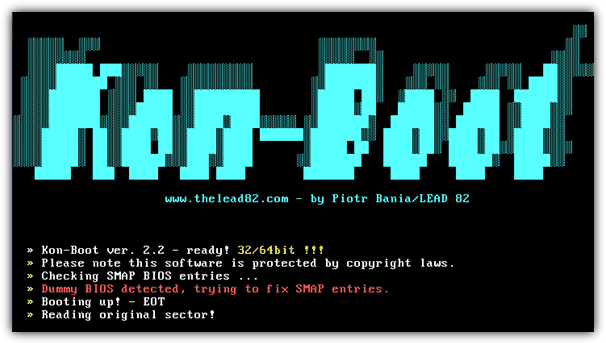
Besides the 64-bit support and compatibility with Windows 8 (when tested, Windows 8.1 did not work with Kon-Boot 2.2), the commercial version also has better support for systems with a UEFI BIOS when you run Kon-Boot from USB flash drive. If you have a UEFI BIOS, make sure the “Secure Boot” option inside the BIOS is turned off. Kon-Boot is known to not work on domain controllers and it also can’t get past hard drive encryption. In the full Kon-Boot package is a simple installer frontend which gives the options of writing the program to CD or USB (with UEFI support). The ImgBurn burning software is required to burn the ISO file to disc.
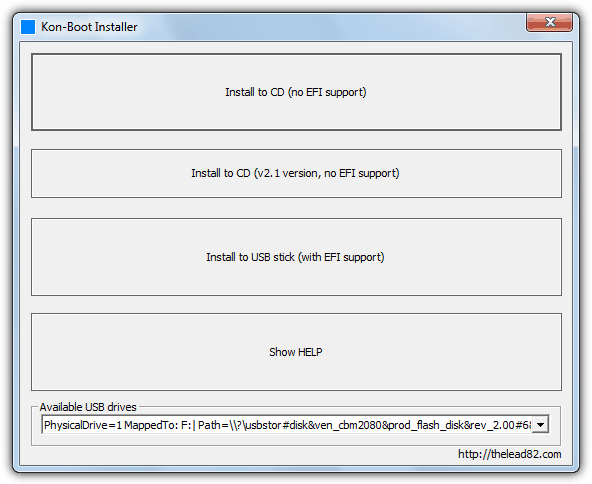
Bypassing a password is done the same way as the free version, boot with Kon-Boot and type anything for the password. Kon-Boot paid is also capable of performing privilege escalation which allows you to perform administrative tasks as a non administrative user or Guest. For example, you can boot up the computer with Kon-Boot, log in as a Guest and add a new user or even reset the administrator password! Here’s how it works:
1. Boot the computer with Kon-Boot and select to login as a Guest user or with your standard user account.
2. Open a Command Prompt (Win key+R -> cmd) and type these commands in turn:
If the whoami command result is “nt authority\system”, then you have elevated privileges and can run commands such as “net user”:

Another paid version feature is “Sticky keys” which is a type of escalation somewhat similar to the privilege escalation above, but this one allows you to open a Command Prompt with System administrator privileges before any users have logged on. The console window will show on the user selection or password entry screen and will allow you to execute similar commands to the desktop privilege escalation function.
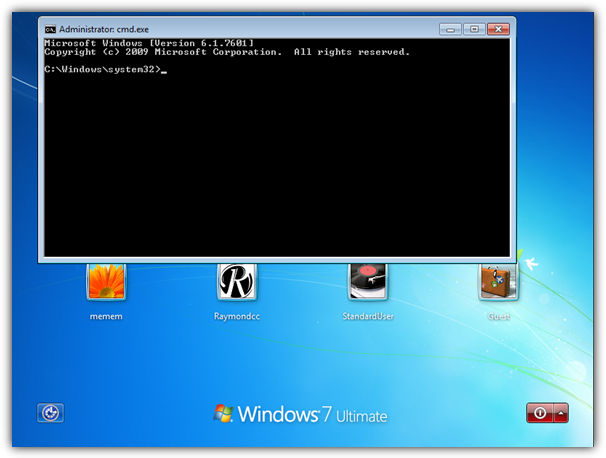
To bring up the Command Prompt, all you have to do is boot your computer using Kon-Boot and when you reach user selection or password entry, simply tap the Shift key 5 times in quick succession. The new console window has “Administrator” in the title bar and a path of “C:\Windows\System32” which tells you this is an elevated command prompt. Do note that the Sticky Keys function needs to be enabled in Windows, and it should be on by default unless you have turned it off manually. Sticky Keys escalation also works in Windows XP but privilege escalation does not.
Although the free version of Kon-Boot is losing it’s effectiveness as time progresses and users move away from 32-bit Windows, it’s still a useful tool to have around while XP, and Vista/7 32-bit is still frequently used. It’s a shame Kon-Boot free will probably not receive any more major updates to make it more compatible with newer operating systems, but all good things come to an end eventually.
For pretty much the ultimate in Windows password bypassing that works on 32-bit, 64-bit and UEFI equipped computers, and does so quickly and easily without changing files, cracking or removing current passwords, the paid version of Kon-Boot is well worth looking at.
Changelog
| Date | Version |
|---|---|
| 10.2019 |
Version 2.1 update released
|
| 06.2019 | Version 2.0 update released |
| 06.2019 | Version 2.0 released |
| 04.2019 | Version 1.9 released |
| 10.2018 | Version 1.8 update released |
| 05.2018 | Version 1.7 update2 released |
| 02.2018 | Version 1.7 update released |
| 01.2018 |
Version 1.7 released
|
| 09.2016 | Version 1.6 released |
| 08.2015 | Version 1.5 released |
| 01.2015 | Version 1.4+ released |
| 10.2014 | Version 1.4 released |
| 01.2014 | Version 1.3 released |
| 06.2013 |
Version 1.2 released
|
| 08.2012 | Version 1.1 released |
| 05.2012 | Version 1.0 released |
Sticky Keys Feature
What’s Sticky Keys Feature?
Sticky keys is a new Kon-Boot escalation feature which allows user to spawn a console window with system admin rights before the user is logged in. Kon-Boot allows you to get console window while the Windows login screen is still active.
Requirements:
- Windows operating system booted with kon-boot
- Sticky keys must be enabled in your target Windows system (they are by default)
- Kon-bootV2.1 and higher
Usage steps:
In order to activate sticky keys feature please tap SHIFT 5 times (FAST). (it should work with default Windows configurations)
Video tutorial available below:
Following commands should be typed manually in the console:
UEFI and Secure Boot feature
Starting from 3.5 version (commercial licenses) Kon-Boot is able to bypass Secure Boot protection on PCs (excluding Apple computers). See for details.
In order to use Kon-Boot in UEFI mode you need to make sure that the UEFI BIOS is not configured to use Secure Boot feature. Secure Boot feature is typically disabled however in case of any problems please enter the BIOS setup and disable the Secure Boot option manually (see examples below).
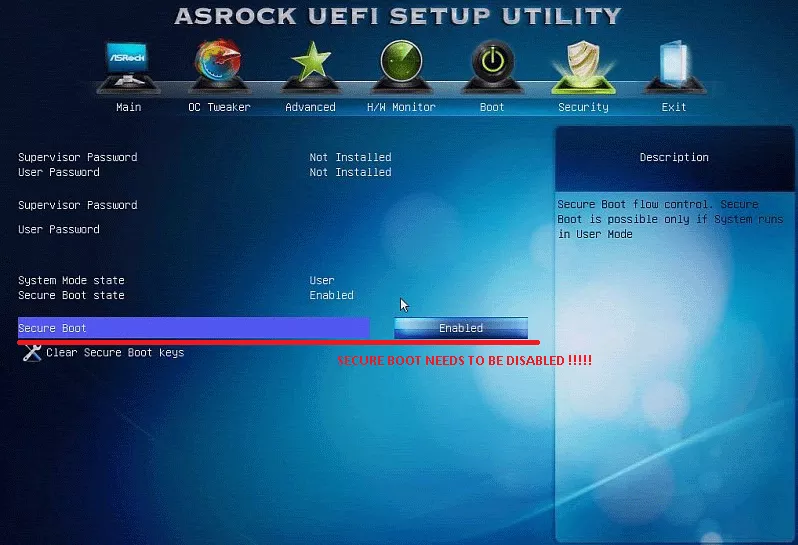 Above: UEFI Secure Boot option on ASRock motherboard
Above: UEFI Secure Boot option on ASRock motherboard
 Above: UEFI Secure Boot option on Samsung motherboard
Above: UEFI Secure Boot option on Samsung motherboard
Disabling Secure Boot feature on Lenovo:
- Set Secure Boot option to disabled
- In the «Restart» tab, select «Disabled» for «OS Optimized Defaults» option and accept potential warnings
- In the «Restart» tab select «Load Setup Defaults» option and accept the displayed warnings
- Exit and save changes
Alternative approach:
- Set Secure Boot option to disabled
- Set the «OS Optimized Defaults» to «Other OS»
- Use the «Reset to setup mode» option in one of the BIOS tabs
- Exit and save changes
If you still have problems check out other youtube videos tutorials on this topic.
Automatic Powershell Script Execution Feature
Starting from version 2.7 (commercial edition only) kon-boot allows user to run automatic powershell script just after the boot of target operating system. Powershell script of user choice is being run with full system rights. This gives excellent and very powerful opportunity for the forensics team to gather all the necessary data from the target system. Right now the feature works only in UEFI mode and on Windows 8 / Windows 10 systems (x64).
Following video presents this feature at work:
In order to use this feature just edit the «auto.ps1» file on your kon-boot USB media.
Will this feature be added to normal (legacy) BIOS mode?
It seems rather unlikely. Legacy BIOS Kon-Boot loader is very hard to maintain, additional unscheduled constant Windows 8 / Windows 10 security updates do not make things easier. Finally UEFI is now recognized as the BIOS replacement. Check our faq for on this topic.
Часть 4. Альтернатива Kon Boot 2. инструмент для восстановления пароля Windows
Существуют различные причины, по которым Kon Boot Windows 10/8/7 может не работать на вашем компьютере. Но вы можете легко восстановить свой пароль, используя инструмент для восстановления пароля Windows как лучшую программу-альтернативу Kon Boot. Он может безопасно сбросить пароль администратора и пользователя на Windows 10/8.1/8/7/XP/Vista и Windows Server 2012/2008(R2)/2003(R2). Это програмное обеспечение — лучшее, что доступно в интернете, и оно дает вам гарантированную скорость восстановления. Вы никогда не потеряете никаких данных во время процесса восстановления пароля, так что не о чем беспокоиться. Вот как вы можете использовать это программное обеспечение:
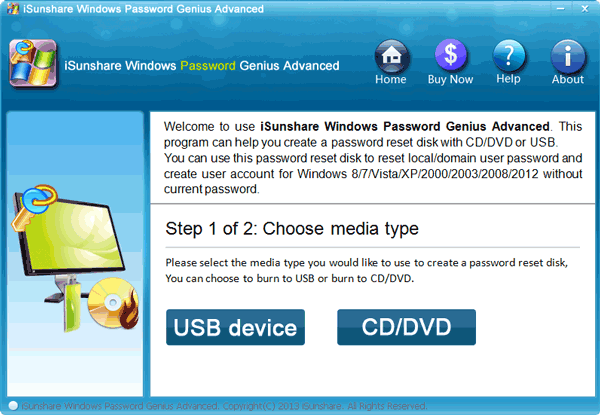
10,000+ Downloads
Ключевые характеристики:
- Восстановить забытый пароль для всех версий Windows в течение нескольких минут.
- Создать новую учетную запись администратора легко без входа в систему.
- Создать USB флэш-диск или CD/DVD диск.
- Поддержка Windows 10, 8.1, 8, 7, Vista, XP, 2000, NT.
- Поддержка Windows Server 2016, 2012, 2008 (R2), 2003(R2), 2000, NT.
1. Загрузите, установите и запустите программное обеспечение на ПК и вставьте пустой USB-накопитель в этотм компьютер. В основном интерфейсе программы вам необходимо нажать на “USB device” и выберите флешку в выпадающем списке.
2. Далее вам нужно нажать на кнопку «Begin burning», чтобы записать диск сброса пароля. Это займет чуть меньше минуты времени.
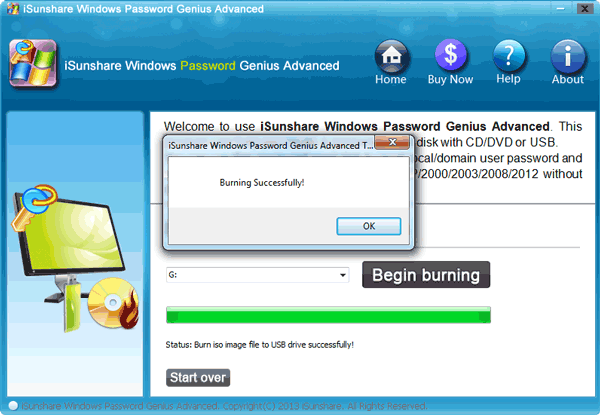
3. Затем нажмите кнопку “OK”, чтобы завершить процесс записи.
4. Затем вставьте загрузочный USB-накопитель в заблокированный компьютер. Затем вам нужно перезапустить его и нажать клавишу ”F12 “или ”ESC», чтобы войти в меню загрузки.
5. Теперь выберите USB-накопитель в качестве загрузочного устройства и нажмите “Enter”, чтобы продолжить.
6. Далее вы увидите интерфейс программы восстановления на экране вашего компьютера.
7. Теперь вам нужно выбрать систему Windows и учетную запись пользователя, пароль которой вы хотите сбросить. Затем нажмите на кнопку “Reset Password”.
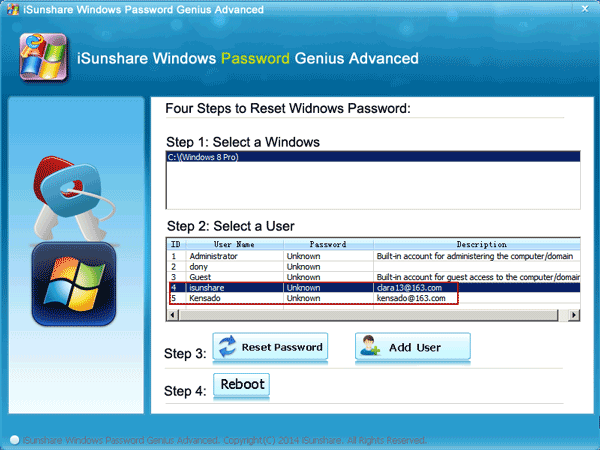
8. После завершения процесса, нажмите на кнопку «Reeboot», чтобы перезагрузить компьютер. Теперь вы сможете войти в свой компьютер без пароля.
После прочтения этой статьи вы получите полное представление о Kon Boot для Windows 10/8/7 и узнаете все о загрузке Kon Boot. Но если ваш Kon Boot не работает должным образом, то здесь вы сможете легко выбрать лучшую альтернативу Kon Boot, чтобы восстановить пароль для входа в систему компьютера. Так что не стоит излишне беспокоиться, просто следуйте нашим рекомендациям и выберите инструмент для восстановления пароля WIndows, чтобы решить вашу проблему.
Part 4. Kon Boot Alternative 2. Windows Password Recovery Tool
There are various reasons that Kon Boot Windows 10/8/7 may not work on your computer. And Most people think that using Offline NT password & Recovery Editor is not comfortable at all. It is true up to some extent. No doubt, it is the quickest way to recover the Windows password but people like friendly interface where they can perform actions openly without getting confused and Offline NT password & Recovery Editor has a complex structure and most of the people fear from running commands because they think this can disturb their system files in case, something went wrong.
Another very useful, comprehensive and extremely customized solution is Windows Password Recovery which is specially designed to recover/remove an admin/local user accounts and passwords. So it is a good replacement for Kon boot. Its graphical interface attracts the customer’s attention and people reset their password just like as they are doing fun.
Features:
- Windows Password Recovery can recover lost passwords for all Windows just within minutes.
- Capable to create entirely new admin account without a password.
- Support Windows 10/8.1/ 8/7/Vista/XP/2000/NT.
- Support bootable USB drive or CD/DVD disk for recovery purposes.
- It can remove the Microsoft account password for Windows 8/10.
How does it work?
Download the latest version of Windows Password Recovery and install it on another operating system. From the main screen, choose a device with which you want to reset the password. Don’t worry, both do the same so it doesn’t matter whatever you choose. These are just provided for your ease.

After inserting the device, choose the respective drive from the dropdown and click on the “Begin Burning” to create the password reset disk.
You can see, currently, the status is Null and there is nothing showing there.

Wait for the software to complete the burning process and after it finishes, it will prompt a success message on the screen.
Now if you see, the status will be indicating that the USB can be used as a bootable media drive.
Insert the bootable USB drive into the target computer and reboot it to get enter into the Boot menu. Choose the Bootable media drive and press the Enter key.

Now, first of all, select a Windows system on which the user account lies. After that, choose that specific user account that is being locked. Click on the “Reset Password” button. Windows Password Recovery will immediately remove the password for that user account.
Click on the “Reboot” button to confirm and see the changes.
After the system reboots, you can sign in to your Windows 7/8/10 without any password.
After reading this article, you will get the full idea about Kon Boot for Windows 10/8/7 and everything about Kon Boot download. But if your Kon Boot is not working properly then you can easily pick the best Kon Boot alternative from here to recover your computer login password. So without worrying too much, just follow the guideline from here and choose Windows Password Recovery Tool to solve your issue.
How to Use Kon-Boot
Once downloaded, extract the files in Windows or with some other free zip/unzip tool. If prompted, the password is kon-boot. Once extracted, you’ll see two folders. Locate the CD-konboot-v1.1-2in1.zip file and extract it, creating the CD-konboot-v1.1-2in1.iso file.
The file names make it look like you’re using Kon-Boot v1.1 but it’s actually v1.0, which you’ll see noted when you run the program.
Burn this ISO file to a disc—a CD is fine. Burning an ISO file is different than burning a normal file so if you need help please see How to Burn an ISO File to a CD. Unfortunately, I was not able to get Kon-Boot working from a USB drive.
After creating the disc, boot from the disc by rebooting your PC with the disc still in the drive. Kon-Boot will start automatically. When you see the Kryptos Logic logo, hit any key. The rest of the process is automatic.
Once Windows starts, just log in to your account with a blank password. It’s also possible that Windows will just log in automatically and skip the password asking process. Either way is fine.
Unlike other password reset tools, this isn’t the end of the story. Kon-Boot has created a special situation where you can access your account but this goes away next time you start your computer. Unless you want to use Kon-Boot to login to Windows every time you start your computer, you’ll need to change your password. Unfortunately, Windows will not let you do that from within your account right now.
To solve this problem, create an administrator account, log off, log on as the administrator, and then reset your account’s password from the account you just created. Once you’ve done that, you can remove the disc, restart your computer, and login to your own account with the new password you created. Feel free to delete the administrator account you created to reset your password from.
Once this is all done, be sure to create a password reset disk so you can avoid using Kon-Boot ever again!
Part 2. Why Kon Boot is not Working?
If your Kon Boot Windows 10/8/7 is not working then there can be various reasons behind that. Here are some of those reasons:
- The behaviour of Kon Boot with the computers BIOS can encourage your antivirus to identify it as a boot virus. So you need to disable your antivirus.
- If you are trying to bypass hard drive encryption, then Kon Boot will not work.
- If the BIOS memory of your computer is too small for Kon Boot to run, then it won’t be compatible with that computer.
- If your hard drive is encrypted by using tools like TrueCrypt or PGP then Kon Boot won’t work.
- If you have disabled CDROM and USB boot while password protecting your BIOS then Kon Boot won’t work.
What’s Kon-Boot for macOS/OSX?
Kon-Boot (aka kon boot, konboot) for Apple Mac OSX systems allows the user to login into the system without knowing the previous passwords and user names. Kon-Boot will either allow you to login into selected account without knowing the password (bypass mode) or it will create new «root» account for you (new-account mode) from which you will be able to change other users passwords as needed. Have you lost your password? Kon-Boot can help!
Our software works by virtually modifying the UEFI bios and then modifying parts of the OSX kernel. Such changes are only made in virtual memory and they disappear after computer reboot.
Windows 10 Online Authorization Support
UPDATE 05.2018:
Windows 10 online account authorization bypass was added to the 2.8 Kon-Boot Release (commercial licenses only, UEFI systems only).
Following video completely illustrates this entire process:
As for personal licenses:
Personal licenses does not offer online authorization bypass on Windows 10 systems. However user can still access the system as local administrator. In fact in the kon-boot v2.5 administrator account can be added automatically, as presented in the following scenario:
- Boot your machine with kon-boot on USB (usb version is required)
- Wait until your Windows 10 machine boots up
- You should see following message displayed on the screen
- If you want to get your new administrator account added click YES and follow the rest of instructions displayed on the screen
In case of problems (i.e. when message box was not displayed) you can add the administrator account manually using the sticky keys feature. Please see the for further details.
I have bought newest version but the screen says differently (version mismatch)
Since Kon-Boot v2.7 one purchased license allows user to install on one and only one selected USB pendrive. Meaning the newest version will be installed only on this one selected USB pendrive (newest Kon-Boot files will be generated only for this device and they will not be visible in the installation package). For usability purposes, older versions of Kon-Boot will be allowed to be installed on a separate USB pendrive.
IN SHORT:
The older kon-boot version you are seeing only indicates that your system is booting kon-boot in legacy mode (older bios — not UEFI). If you would run the same pendrive under UEFI (bios replacement, currently standard) you would see the newest kon-boot logo and version.
In short the BIOS part version can be older, the UEFI kon-boot part gets updated (see previous point for details).
Introduction: Step-by-step Tutorial to Install Kon-Boot on USB.
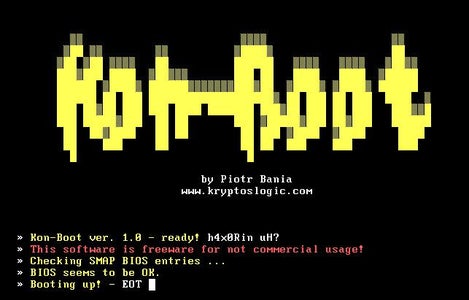 By BjarkeFollow
By BjarkeFollow
More by the author:
About: I make things, just like everyone else around here.
More About Bjarke »
(Kon-Boot is’nt free anymore) In this step-by-step tutorial i will show you how to easily install Kon-Boot on your USB. Kon-Boot is a handy tool to have when you forget your password to your Windows user. I would be installing the free version of Kon-Boot but you can buy the full version. Requirements Kon-Boot is able to work with following operating systems: Operating system Free version Full version Microsoft Windows XP Home Edition (Service Pack 2+) Yes Yes Microsoft Windows Vista Home Basic 32Bit/64Bit 32-Bit Only Yes (FULL SUPPORT) Microsoft Windows Vista Home Premium 32Bit/64Bit 32-Bit Only Yes (FULL SUPPORT) Microsoft Windows Vista Business 32Bit/64Bit 32-Bit Only Yes (FULL SUPPORT) Microsoft Windows Vista Enterprise 32Bit/64Bit 32-Bit Only Yes (FULL SUPPORT) Microsoft Windows Server 2003 Standard 32Bit/64Bit 32-Bit Only Yes (FULL SUPPORT) Microsoft Windows Server 2003 Datacenter 32Bit/64Bit 32-Bit Only Yes (FULL SUPPORT) Microsoft Windows Server 2003 Enterprise 32Bit/64Bit 32-Bit Only Yes (FULL SUPPORT) Microsoft Windows Server 2003 Web Edition 32Bit/64Bit 32-Bit Only Yes (FULL SUPPORT) Microsoft Windows Server 2008 Standard 32Bit/64Bit 32-Bit Only Yes (FULL SUPPORT) Microsoft Windows Server 2008 Datacenter 32Bit/64Bit 32-Bit Only Yes (FULL SUPPORT) Microsoft Windows Server 2008 Enterprise 32Bit/64Bit 32-Bit Only Yes (FULL SUPPORT) Microsoft Windows 7 Home Premium 32Bit/64Bit No Yes (FULL SUPPORT) Microsoft Windows 7 Professional 32Bit/64Bit No Yes (FULL SUPPORT) Microsoft Windows 7 Ultimate 32Bit/64Bit No Yes (FULL SUPPORT) Please note: Full support also includes the privilege escalation feature. Additional requirements: — Pentium III compatible processor, 10MB free space on the hard drive. CD-ROM, Floppy Drive or USB flash drive, keyboard, Internet connection (for product download). Compatibile BIOS version. Warning: Kon Boot may not work on all PC machines due to different (often old) BIOS versions.
My antivirus detects Kon-Boot as a virus, is it a malicious code?
Nope, Kon-Boot is not a virus and does not contain any malicious code. Antiviruses sometimes flag it as a «hacking-tool» and we can’t really do anything about it. We suggest disabling your antivirus when creating a Kon-Boot CD, Floppy, or USB flash drive. If you want to read more about false-positive antivirus problems please click .
Additionally please note Kon-Boot was firstly released in 2008 up to this day there are no reports whatsoever about malicious Kon-Boot behavior despite thousands of users worldwide. Many from who are top notch computer security professionals that hunt malware for a living.
My Thoughts on Kon-Boot
Kon-Boot v1.0 is one of my favorite Windows password reset program, mainly because it’s so fast and easy to use. I’d rank it higher among the other options available but it doesn’t support 64-bit operating systems nor any edition of Windows 8 or Windows 101.
However, since it works so differently than Offline NT Password & Registry Editor, Kon-Boot is an excellent alternative if you need your Windows password reset and that free tool hasn’t worked for some reason.
Kon-Boot requires a few post-cracking steps to be a real Windows password reset solution but nothing required by this amazing program is too difficult for anyone with the very serious problem of being locked out Windows.
Error: this USB drive is using odd USBSTOR serial path
If you have seen «Error: this USB drive is using odd USBSTOR serial path , please consider using USB pendrive from different vendor» message it means that Kon-Boot installer has detected a potentially incompatible USB pendrive. Kon-Boot tries to detect potentially incompatible USB pendrives in order to minimize various BIOS problems in the future.
At this point it is highly recommended to use different USB pendrive for Kon-Boot installation (preferably from different vendor (manufacturer)). Basing on our experience KINGSTON, SANDISK pendrives are the most reliable ones but basically any pendrive which capacity not larger than 16 GB will do (as long as it is accepted by the installer and this error disappears).
Step 5: Multiple Ways to Get Into a Windows Account/PC
In this step I will show you how to get in to an Account/PC
> The Easiest Step:
The easiest step to bypass a login screen is to choose the user you want and then just hit »Enter». But there is a big chance that this easy step doesn’t work on Windows 8/8.1/10.
> Other ways using Cmd (The following commands need to be entered WITHOUT the quotes » )
To get into a Windows PC/Laptop using Cmd, you just have to »Tap» 5 times the ‘Shift’ button when you are on the lock screen, this will open the Command Prompt with Administrator rights.
— Add a User without password: net user »username»
— Add a User with password: net user »username» »password»
— Give new/existing user admin rights: net localgroup administrators »username» /add
— Remove Admin Rights: net localgroup administrators »username» /del
— Change user password: net user »username» *
— Change user password way nr2: net user »username» »newpassword»
Note: When typing a new password (when used the command with *), you will have to know that you don’t see the password when you type.
How to change profile password?
Please note: this is only for local accounts:
To change your password you can try the following way (after booting with kon-boot):
- Navigate the Start Menu to Control Panel
- Select «User Accounts and Family Safety»
- If the User Account Control window appears click «Yes» and leave the password field empty
- Select «Create a new account»
- Create the account (pick a name) and set the permissions (administrator).
- Disconnect Kon Boot and restart the computer to restore original Windows
authentication functionality.
After restart:
- Select your new User Account (the account you have created)
- Navigate the Start Menu to Control Panel
- Select «User Accounts and Family Safety»
- Select the target User Account (the one you want to change)
- Select «Change the password»
- Input the new information for the account and click «Change password»
- You are done
Disable virtualization support in BIOS
Newer Windows version use Virtualization-based Security (VBS) and/or hypervisor security. This can cause BSODs (Blue Screen Of Death) during loading Windows with Kon-Boot (Kon-Boot does not support virtualization). In order to prevent this from happening go to your BIOS setup and temporarily disable virtualization support (VT/VT-x) as presented on screenshots below.
This step is optional, try it if you experience Blue Screen of Death during booting your target Windows machine with Kon-Boot.
Following screenshots present how to disable virtualization support on various BIOSES (don’t forget to SAVE the changed settings).

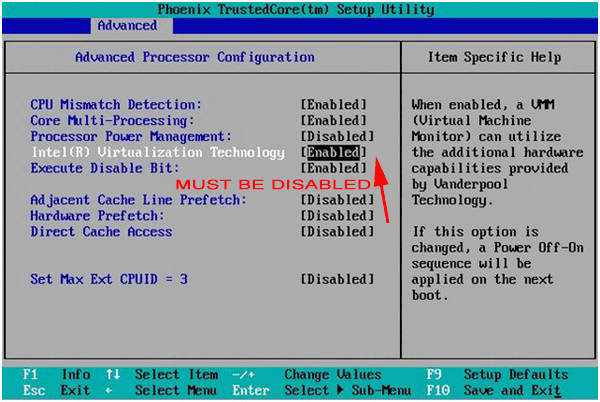

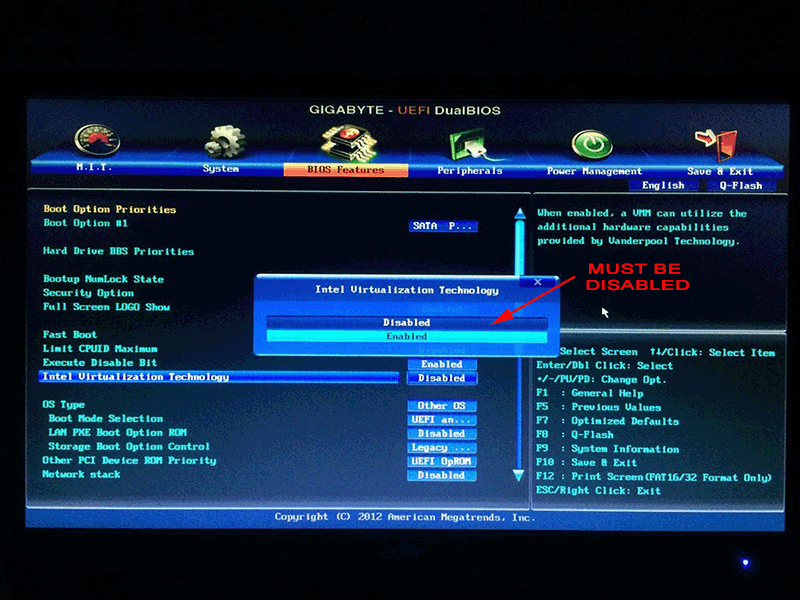

Installation to USB
Since version 2.7 kon-boot can be installed only by using our GUI installer. Internet connecton is required for installer to work. Please note that all other installation options like CD installation are depracated (older kon-boot version is included in the package for compatibility reasons or in case of temporary lack of Internet connection).
We recommend using USB pendrive with less than 16 GB capactity, although it is not necessary (some older BIOSes have problems with kon-boot loading from larger USB pendrives).
Please use USB pendrive manufactured by reputable company like KINGSTON, SANDISK, SONY. Please don’t use USB pendrives from «NO-NAME» companies — they may cause problems on various BIOSES.
Following video presents installation to USB pendrive media:
Windows loads but nothing happens
If you have installed Kon-Boot correctly and configured your BIOS to boot from Kon-Boot media you should at least see the Kon-Boot . If you can’t see that screen please verify your Kon-Boot media and most importantly please check if you have configured your BIOS to boot from Kon-Boot media — this step is crucial.
Assuming you have seen the Kon-Boot initial screen, target Windows system loaded correctly afterwards but still after few minutes nothing happened:
- Make sure your target Windows system is not using disk encryption — disk encryption is not supported
- Some of the newest Kon-Boot features may be not present on some systems (due to system configuration) therefore we recommend trying the and booting from this newly created media.
If this does not resolve your problems please contact us for support
Manual installation to USB
Available for kon-boot v2.6 (if you use this feature in kon-boot v2.7 the older version (2.6) will be installed)
Requirements:
- Your BIOS need to be configured to start from the USB media. If you don’t know how to configure your BIOS please check external video tutorials — here
- USB thumb drive (FAT32 filesystem)
Please note: files located on your USB thumb drive may be overwritten!
Installation steps:
- Insert your target USB pendrive
- If you are using Windows Vista or newer system please right click on «usb_install_RUNASADMIN.bat» and pick «Run As Administrator» option. Otherwise just double click on «usb_install_RUNASADMIN.bat» file (bat files are located in the «kon-bootUSB» directory, so by default the entire path is «c:\kon-boot\kon-bootUSB»)
- Follow the displayed instructions. USB Tutorial video is available here
Плюсы и минусы
Благодаря тому, что, как и большинство другого софта, Kon-Boot for Windows обладает характерными сильными и слабыми сторонами, это позиционирует ее место на рынке системных утилит.
Достоинства:
- Скорость срабатывания.
- Запуск в PreOS-режиме.
- Собственное меню загрузки, запускаемое еще до старта основной ОС.
- Практически незаметные системные требования.
- Кроссплатформенность.
- Простота использования.
К недостаткам программы относят отсутствие русского языка и периодически возникающие сбои.
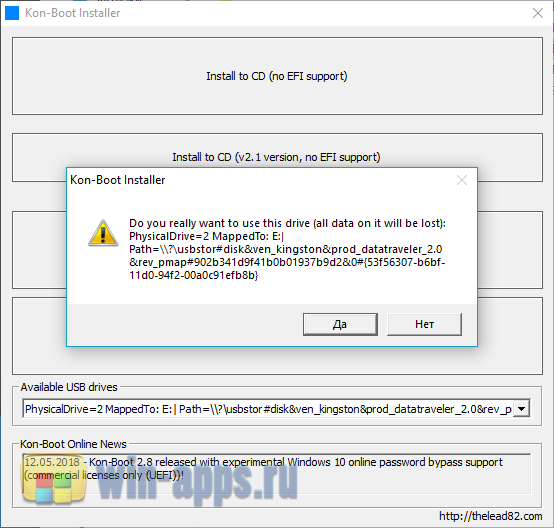
Далее мы кратко расскажем, как записать утилиту на диск и с ее помощью взломать нужную операционную систему.
USB Installation Guide (Manual)
Please note: this method works only till version 1.6; version 1.7 must be installed using .
Kon-Boot for Mac USB installation steps on OSX, video tutorial is available below:
- Extract your Kon-Boot package to the directory of your choice.
- Insert your USB thumb drive
- Open Disk Utility, select your USB thumb drive and pick up the erase option (with MS-DOS FAT as parameter)
- Now pick the «Partition» option (still in the Disk Utility window) and select «1 Partition» from the Partition Layout box.
- Now click «Options» below and make sure the «Master Boot Record» option is selected.
- Click «Apply» and later «Partition» to proceed.
- Now please copy the «EFI» folder from the package you have received to the top directory of your USB thumb drive.
- You are ready to use Kon-Boot for Macs.
- Reboot your target Mac machine (with your Kon-Boot media inserted) while pressing the option key (left alt).
- Pick the «EFI boot» option from the boot manager.






